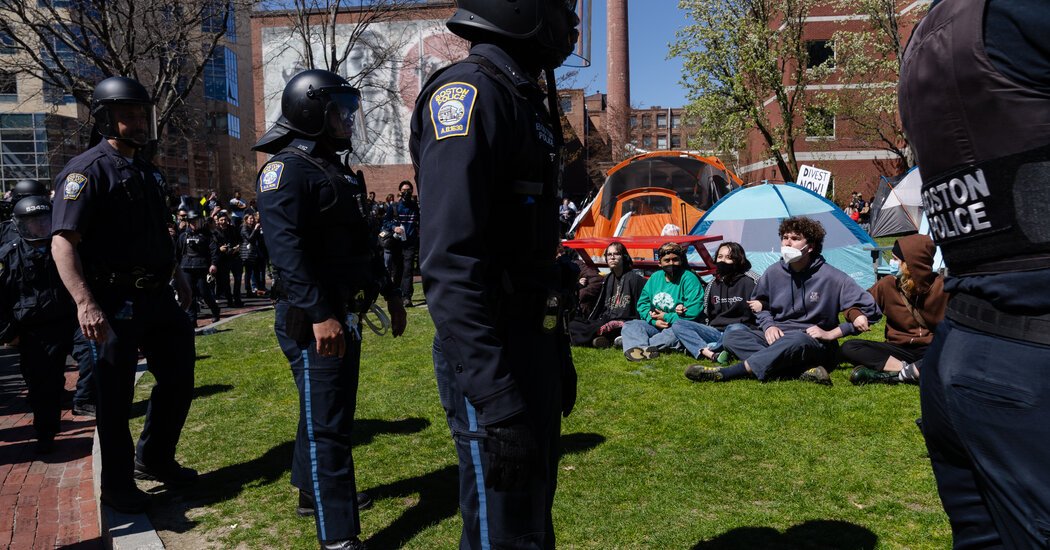Wearing riot helmets and carrying zip ties, Boston police officers moved in one day this week and surrounded a group of pro-Palestinian protesters on a grassy patch of Northeastern University’s campus. Six police wagons were idling nearby, and an officer had issued a terse warning. Mass arrests looked imminent.
Then, without explanation, the riot police packed up and left.
The sudden end to the standoff produced cheers from the protesters, and confusion for those who had been bracing for chaos. In recent days, police officers have rushed in to break up student encampments at the University of Southern California, Emerson College in Boston and Ohio State University. At Emory University in Atlanta, officers used pepper balls and wrestled protesters to the ground, ultimately arresting 28 people.
On quads and lawns from coast to coast, colleges are grappling with a groundswell of student activism over Israel’s ongoing military campaign in Gaza. Administrators are having to make controversial decisions over whether to call in the police, and are often criticized regardless of the route they take.
“They don’t seem to have a clear strategy,” said Jennie Stephens, a professor at Northeastern who attended the protest there to support the students. “I think there’s this inclination to kind of control what’s happening on campus, but then that’s balanced with the optics — or the violence, or the real harm — done to students or faculty or staff or others if there are arrests.”
At Northeastern, where about 100 protesters had linked arms in a circle around a half-dozen tents on a lawn known as the Centennial Common, it was unclear exactly who was directing the police response.
The dean of students and the university police had warned protesters that they would be considered trespassers if they did not produce a student ID. The dean then went around the circle asking students for the cards; some showed them, but many did not.
A university spokeswoman said in an email that the Boston Police Department had ultimately made the decision for its officers to leave without making arrests. She declined to say whether Northeastern had called the police to campus or whether it had asked officers to arrest those without IDs, saying that the university does not comment on “operational details related to public safety.” The police did not answer questions about the protest.
The same police force had taken a much different tack on another Boston campus just 12 hours earlier, when officers stormed a student encampment in an alleyway at Emerson, a small private college downtown, ripping down tents and throwing students — who had formed a barricade and refused to leave — to the ground.
The police arrested 118 people there, infuriating some students who said that the university had failed to protect them. But city officials defended the operation, saying it was necessary to clear the alley, which includes a public right of way.
“The issue was just around fire hazards that were being created with the tents, and the public health and safety risks that were happening there as well,” Boston’s mayor, Michelle Wu, told WCVB-TV.
Pro-Palestinian encampments on college campuses have swiftly multiplied since Columbia University students launched theirs this month. They have at times drawn ire from students and faculty who complain about what they see as antisemitic chants and a lack of safety for Jewish students, and off campus, from supporters of Israel’s military operation in Gaza.
So far, more than 34,000 Palestinians have died during the Israeli bombardment and invasion of Gaza, a response to an attack led by Hamas on Oct. 7 in which 1,200 Israelis were killed and about 250 people were taken hostage.
At Columbia, where the president was already under fire from Republicans in Congress, the administration took an aggressive approach at first, calling in the New York Police Department, which arrested more than 100 people and removed tents. But students quickly returned, pitching new tents and vowing to stay.
This time, rather than calling in the police again, Columbia officials are negotiating with the protesters. On Tuesday, the university gave a midnight deadline for the protesters to leave. After the deadline came and went, the university said a small group of faculty, administrators and university senators were talking to student organizers “to discuss the basis for dismantling the encampment, dispersing and following University policies going forward.”
“We have our demands; they have theirs,” a spokesman for the university, Ben Chang, said in a statement.
At Emory University, where the police arrested students and faculty members on Thursday, the university’s president, Gregory L. Fenves, said flatly that the institution would “not tolerate vandalism, violence or any attempt to disrupt our campus through the construction of encampments.”
Harvard has tried a different approach. The university restricted access to its historic Harvard Yard, allowing in only those who showed a university ID, and suspended a pro-Palestinian group, saying that it had held an unauthorized demonstration.
But the group and its supporters set up an encampment in the yard nonetheless. On Wednesday night, the mood was serene, with a couple of campus police officers sitting in cars at the edges of the yard and students passing through. Still, the university has faced criticism from some prominent alumni, including its former president, Lawrence H. Summers, who said that allowing the tents to stay up was a “profound failure.”
Like Harvard, the University of Texas at Austin sought to pre-empt students’ planned encampment, warning that it was unauthorized, and students gathered anyway. Unlike at Harvard, administrators responded with force. Dozens of police officers, many in riot gear or on horseback, pushed through throngs of protesters on Wednesday to block off the campus’s main lawn, ultimately booking 57 people into the county jail.
But by evening, almost all state and local police officers had disappeared. Students quickly returned and gathered with picnic blankets before leaving for the night.
Jay Hartzell, the university’s president, said in a statement that administrators had prevented the planned protest out of fear that students would try to “follow a pattern” and “severely disrupt a campus for a long period.” In messages that were obtained under a public information request, Mr. Hartzell told a lawmaker that he had asked for help from the state police force because the school’s police “couldn’t do it alone.”
As of Friday night, about 300 of the university’s 3,000 faculty members had signed an open letter of no confidence in Mr. Hartzell. “President Hartzell needlessly put students, staff and faculty in danger. Dozens of students were arrested for assembling peacefully on their own campus,” it said.
On Thursday, another protest at the university was scheduled, but the scene was much more calm, with university administrators handing out fliers with rules for protesting. One administrator told students that the police had assured her that they would not arrest students unless they tried to put up tents or stay past 10 p.m.
Kathy Zoner, who was the police chief at Cornell University in Ithaca, N.Y., for nearly a decade until 2019, said that university administrators often hoped to avoid responsibility for the police response to protests, but that they themselves often made the final decision on what to do.
She said protesters who came from outside the university can be hard to deal with because they cannot be threatened with academic consequences and might be more intent on agitation than dialogue. The recent tent encampments can be a particular problem for administrators who are focused on the school’s optics, Ms. Zoner said.
“This is the big concern, right? That these encampments will be there forever, whatever that means, and that it becomes a reason for people to not choose your university or college to attend,” she said. “And face it: Colleges are businesses. Not-for-profit or for-profit, they’re a business. They have a bottom line and have to be attentive to it.”
That is just one issue facing administrators in a crisis. Daniel W. Jones, a former chancellor of the University of Mississippi, said students, faculty members, elected officials, parents and donors all offer often starkly different advice on how the university should respond.
“I think the biggest tension is around, am I going to act in the best interests of students on my campus, or the best interests of my board, the politically interested people and alumni broadly?” he said.
Nicholas B. Dirks, a former chancellor of the University of California, Berkeley, said there were few more challenging decisions for a university leader than whether to summon the police, in part because outside law enforcement officers may use tactics far different from those of a campus police force.
“University presidents are assumed to have total power and control, so bringing in an external police force, you know the first thing that’s going to happen is you lose control over the situation,” said Dr. Dirks, who was a senior administrator at Columbia before he took charge at Berkeley in 2013.
At Berkeley, he said, he had been extremely reluctant to bring in off-campus police officers except when there appeared to be credible threats of violence.
“You’re in a kind of crisis situation, so you are balancing what is partial, always incomplete information with a kind of time urgency where you really feel you have to make very, very quick decisions, and it’s not the best time to make clear calls,” Dr. Dirks said.
“They are decisions under fire,” he added.
Reporting was contributed by Karla Marie Sanford and Eryn Davis in New York, Matthew Eadie in Boston and Sean Keenan in Atlanta.




